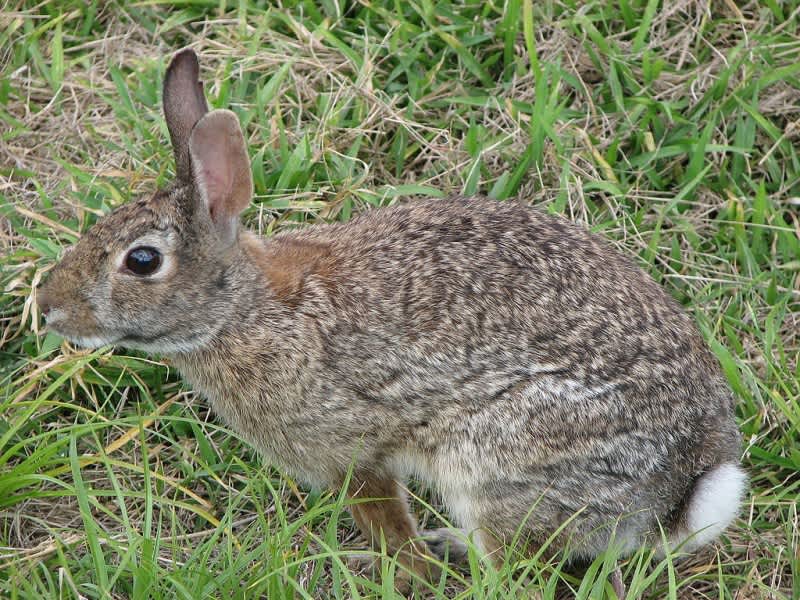Rabbit Hunters Take Note: Steps to Avoid Tularemia
The Professor's Blog 02.25.13

Hello all, in the previous blog I indicated that I would talk about Toxoplasma gondii and Trichinella spp. in feral pigs. However, recently two rabbit hunters in eastern North Carolina tested positive for tularemia so I decided to address the current event first.
Rabbit hunting is a fantastic hunting experience and I fondly remember many days hunting rabbits with friends and family in northern Indiana. There are many reasons that I enjoy rabbit hunting. First, hunting rabbits can be as simple as walking a field, fencerow, or edge by yourself or with a friend or two. Second, you can wander through the field systematically or haphazardly. Third, you can increase the experience and excitement by working a thick briar patch with a pack of beagles and four or five close friends. Fourth, you can hunt rabbits anytime of the day–you do not have to get up at o’dark thirty. I am sure you have additional reasons that you enjoy rabbit hunting and I would love to hear them. Nevertheless, the excitement when a rabbit breaks cover is hard to beat.
Tularemia is often called rabbit fever, deer fly fever, meat-cutter’s disease, Ohara disease, and Francis disease. It is a zoonotic (can be passed from wildlife to humans) disease caused by the bacterium Francisella tularensis. Francisella tularensis naturally occurs in the environment, can survive in water and soil for weeks, and is common in rabbits, hares, and rodents. In fact, tularemia has been documented in over 150 wildlife species and is responsible for killing large numbers of wild animals. Tularemia occurs primarily in the Northern Hemisphere and has been reported throughout North America, Europe, Asia, northern Africa, and the Middle East, and recently a case was reported in Australia. In the United States, approximately 200 human cases are reported each year with reports from every state except Hawaii.
In rabbits, the symptoms include a white- or yellow-spotted liver and the liver and/or spleen may be a dark bluish-red and appear very swollen. Additionally, you may notice external ulcerations or infected areas where the animal was bitten by a tick or deer fly.
Humans most commonly become infected through skin contact with infected animals (e.g., rabbits), ticks, deer flies, bites from infected cats, eating improperly cooked meat, drinking contaminated water, or inhaling airborne bacteria. In the United States, rabbits are the source of infection in 90 percent of the cases, 70 percent of which comes from the cottontail rabbit genus Sylvilagus (16 species in this genus are recognized worldwide).
The incubation period for tularemia in humans is usually three to five days after exposure but can range from one to 14 days. The signs and symptoms depend on mode of exposure. Possible symptoms include skin ulcers and rashes, swollen and painful lymph nodes, inflamed eyes, sore throat, mouth sores, diarrhea, or pneumonia. If inhaled, symptoms can include fever, chills, headache, muscle aches, joint pain, dry cough, and progressive weakness. People with pneumonia can develop chest pain, difficulty breathing, bloody sputum, and respiratory failure. Tularemia can be fatal if not treated with appropriate antibiotics.
Last week, I provided some simple recommendations for hunters who clean feral pigs. Many of the recommendations are the same for rabbits. Hunters should always wear long sleeves, gloves, and eye protection when cleaning any game animal. After cleaning the animal, clean and disinfect all knives, clothing, or cleaning surfaces and absolutely make sure to wash your hands and forearms frequently and carefully with soap and water. Additionally, avoid drinking unfiltered or unclean water from streams and rivers. Insect repellents containing DEET have been shown to help prevent tularemia.
Hunters should avoid eating rabbits that appear in the field to be “lazy” or do not act “normal.” During the cleaning process, be sure to wear gloves, and hunters should examine the external surfaces of the rabbit for any infected areas. ALWAYS check the liver for the appearance of white or yellow spots. Even if the liver appears bright, does not have spots, and the rabbit appeared healthy in the field, make sure to cook the meat thoroughly; F. tularensis are killed by heat above 160 F.
As always, as long as these proper precautions are taken there is no reason not to enjoy your favorite fried or braised rabbit or hasenpfeffer.

